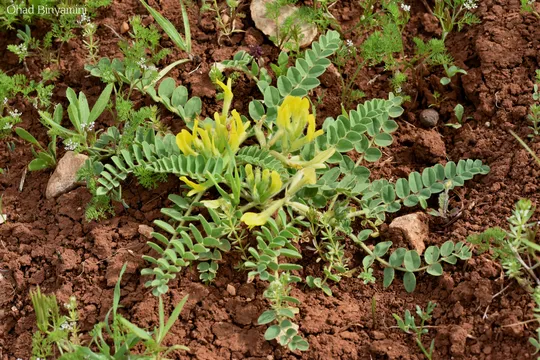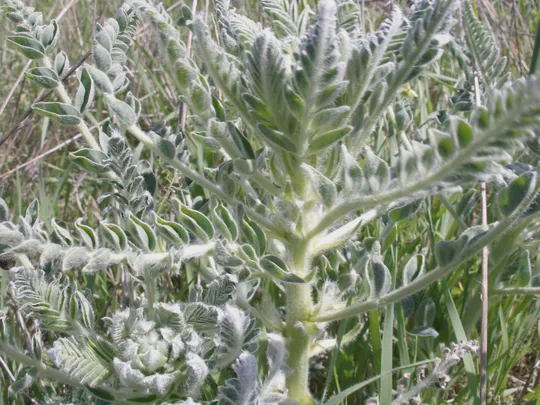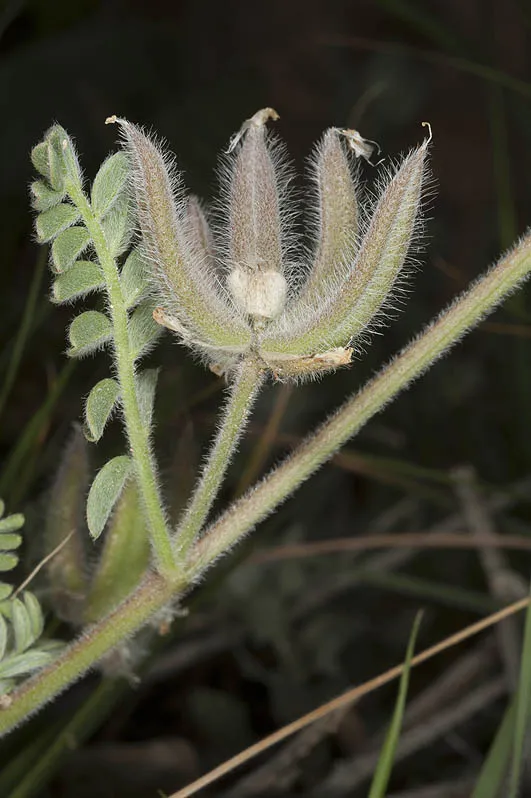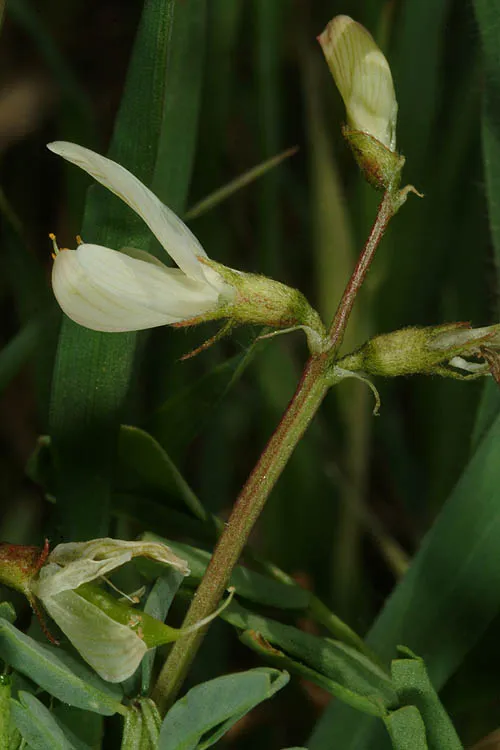Sparse Milk-vetch
Astragalus sparsus
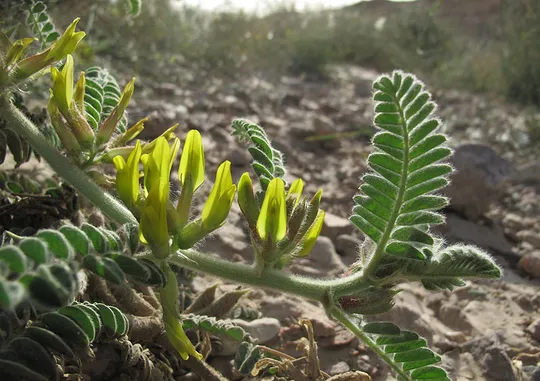
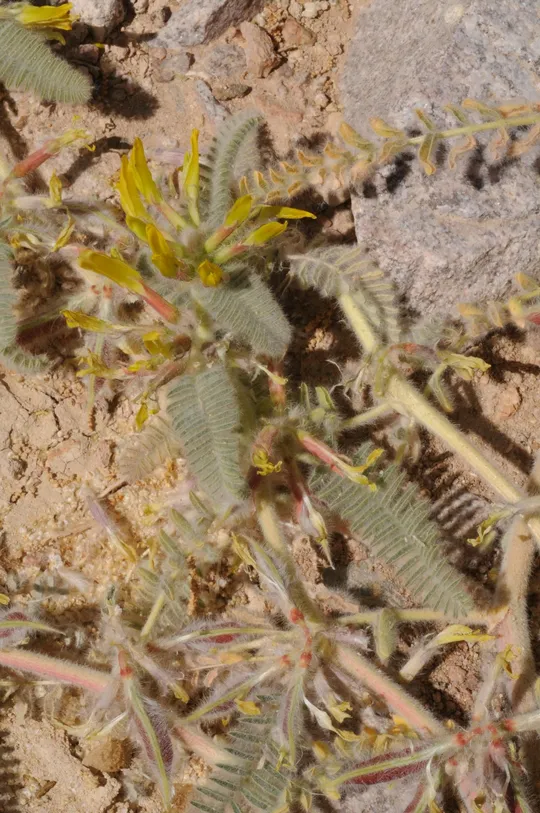
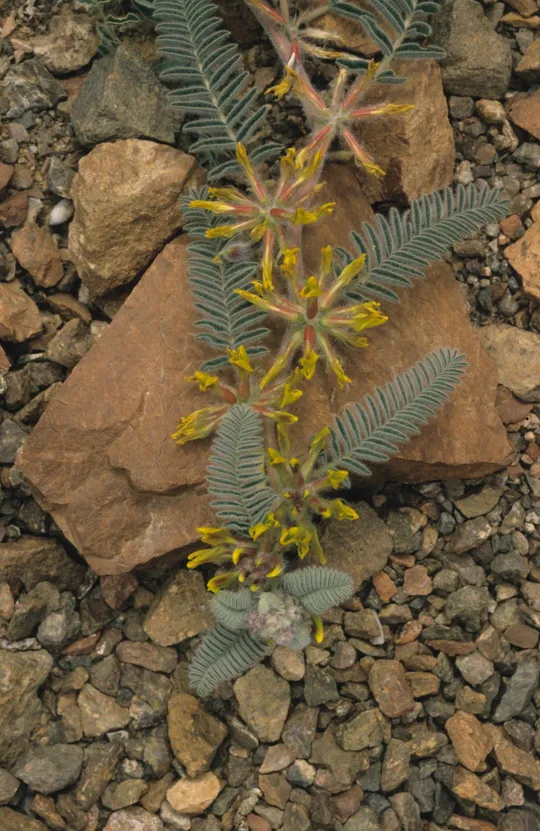
Astragalus sparsus grows in the Elat
Mountains and the Arava, on 18 recorded sites, and there are an estimated 30
sites. In the Elat Mountains it was recorded and collected several times
between 1955 and 1988 at three sites in Wadi Shlomo and Wadi Garof. It is
extinct from another site near the city. Following the rainy winter of 2010, 11
new sites were found in the lower Elat Mountains and around the city. In the Arava
it was observed at three sites in Wadi Shalhav and north of Elot (Mimi Ron).
Gravel and sandy streambeds in the extreme hot desert that
have an annual precipitation below 50 mm.
For the characteristics of the genus, see Astragalus
trimestris. For the local and global distribution of Astragalus
species – see A. oocephalus.
A.
sparsus belongs to the group of the "giant Astragalus" species which
have very long leaves and an erect unbranched central stem, which reach a
height of up to 120 cm; they are known as the A. macrocarpus section and named for its most
common Mediterranean species (Sec. Astragalus, Podlech, 2005). This section
includes about 40 species growing from Afghanistan and Kyrgyzstan in Central
Asia, westward to Turkey and Greece. Three species grow in Spain and in the
Atlas Mountains, and they may be seen as a relictual section from the time when
Irano-Turanian vegetation penetrated from Asia to North Africa. The section center
is in Afghanistan, from where 21 species were described. In the Levant, two
common species represent the group: A. macrocarpus
in the Mediterranean region and A. aleppicus
in the transition zone, from which the two desert species were probably derived
– A. sparsus and A. fruticosus. The large fruit of A. macrocarpus and A. aleppicus is – thick
and ovoid, and the fruit of the desert species is a narrow elongated pod more similar
to the fruit of the Coronopus section, which includes A.
dactylocarpus, A. trigonus and A. sieberi. The members of the Coronopus
section have long sharp thorns formed from the hardened leaf petioles from previous
seasons.
In the wake of Eig’s monograph (Eig, 1955), Zohari
(Flora Palaestina, 1972) divided the Astragalus species with unbranching central
stems differently (better in our opinion).
He placed A. macrocarpus and A. aleppicus in the "large fruit" section, that includes species with a
cork-like thick-walled pod and all the other species were placed in the Coronopus
section, which has an elongated pod with many seeds. According to Zohari, in
the first section the leaf petioles survive (remain on the stem), and in the
second section are very thorny (this identifying sign does not apply to A. sparsus).
·
Astragalus
sparsus is limited in Israel to two regions and there has
been no change in the number of regions over tens of years in which it was
collected or reported. The number of sites increased greatly after the rainy
winter of 2010 in the Arava and in the southern Negev, compared to what was known
until then. The number of sites where the species is dormant in its seed bank is
greater than the number of sites where it was actually observed in a given season.
There is a lack of documented information regarding this over the years, and
the change trends in the number of sites over the years are not clear.
·
A. sparsus grows mainly in a pattern of widely scattered individuals far apart.
There is no verified quantitative information on the number and size of
populations at each site.
·
It is possible
that the climatic trend of drying and the decrease in the number and intensity
of floods in the wadis of Elat and the Arava (if indeed it is happening) will
affect the possibility of renewal from the seed bank and may lead to the
extinction of populations. All-terrain vehicular activity in the wadis harms A. sparsus,
as it does other plants characteristic of streambeds.
·
The sites in Wadi
Shlomo are located
in the Massif Elat Nature Reserve.
·
A. sparsus
appears in the Red species list of Egypt.
Long-term systematic monitoring of previously documented
sites in the Elat Mountains and Arava wadis should be conducted to study the
dynamics of individuals, populations and sites. Care should be taken not
to damage vegetation in the wadi channels in these areas.
Astragalus sparsus grows in the
eastern Saharo-Arabian region: Israel, Southern Jordan, and Sinai in Egypt,
Arabia, Qatar and Yemen.
Astragalus
sparsus
is a rare perennial herb characteristic of the wadis in the Arava and the Elat
Mountains, which appears irregularly, in sparse populations. It is a peripheral
species whose global distribution limit is in southern Israel.
ראה קדד לביד.
Current Occupancy Map
| 1000 squre meter pixel | 5000 squre meter pixel | 10000 squre meter pixel | |
|---|---|---|---|
| number of observations | 0 | 0 | 0 |
| in total pixels | 0 | 0 | 0 |
| Family | Fabaceae |
| Classification | On the endangered species list |
| Ecosystem | Desert |
| Chorotype | Eastern Saharo – Arab |
| Conservation Site | Wadi Shlomo |
| Rarity |
1
5
6
|
|---|---|
| Vulnerability |
0
3
4
|
| Attractiveness |
0
0
4
|
| Endemism |
0
0
4
|
| Red number |
1
4.7
10
|
| Peripherality | S |
| IUCN category | DD EW EX LC CR EN VU NT |
| Threat Definition according to the red book | Endangered |
 Based on:
Based on:
